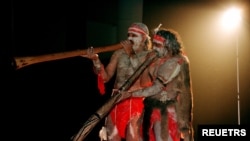Native American language experts have been in Central Australia to try to save Indigenous languages from extinction.
Only around 20 people speak Pertame Southern Arrernte, which originated near the city of Alice Springs in Central Australia.
Government policies had tried to eradicate Indigenous languages until the 1970s.
The consequences are still being felt. Recent census data shows that 167 First Nations languages are spoken in Australia, but more than 100 are either severely or critically endangered.
North American experts have traveled to the Australian desert to share their experiences of reviving traditional expression.
Julian Lang is from northwestern California in the United States. He has seen his Karuk language thrive under an immersive teaching method called "language hunting,” in which an elder teaches a student, or an apprentice, over three years.
Lang told the Australian Broadcasting Corp. the system has worked well.
“One person teaches another person and that person becomes a seed for so many more," said Lang. "The apprentice, well, learns how to elicit more knowledge from the elder. We call it language hunting. So, they seek out more and more language and as you get to a certain level you finally get to that point where you are conversing relatively easy.”
The so-called North American master-apprentice program was developed more than 30-years ago.
There are no books or curriculum. Instead, teaching is based on everyday activities, and words and understanding are acquired gradually. Lang says the process takes about 900 hours over three years.
The United Nations has declared the next 10 years as the International Decade of Indigenous Languages. For First Nations Australians, learning their ancestral language helps them to reconnect with their identity and culture.
Indigenous languages are not just a means of communication, they express knowledge of all aspects of society; from history and family relationships to astronomy and food.
In 2019, history was made in Australia after a politician in the Northern Territory spoke an Aboriginal language with an interpreter for the first time in Parliament. The fight to use Indigenous languages in the chamber had lasted for years. In the past, politicians were told to speak only English in Parliament, and that it would be “disorderly” if they didn’t.





